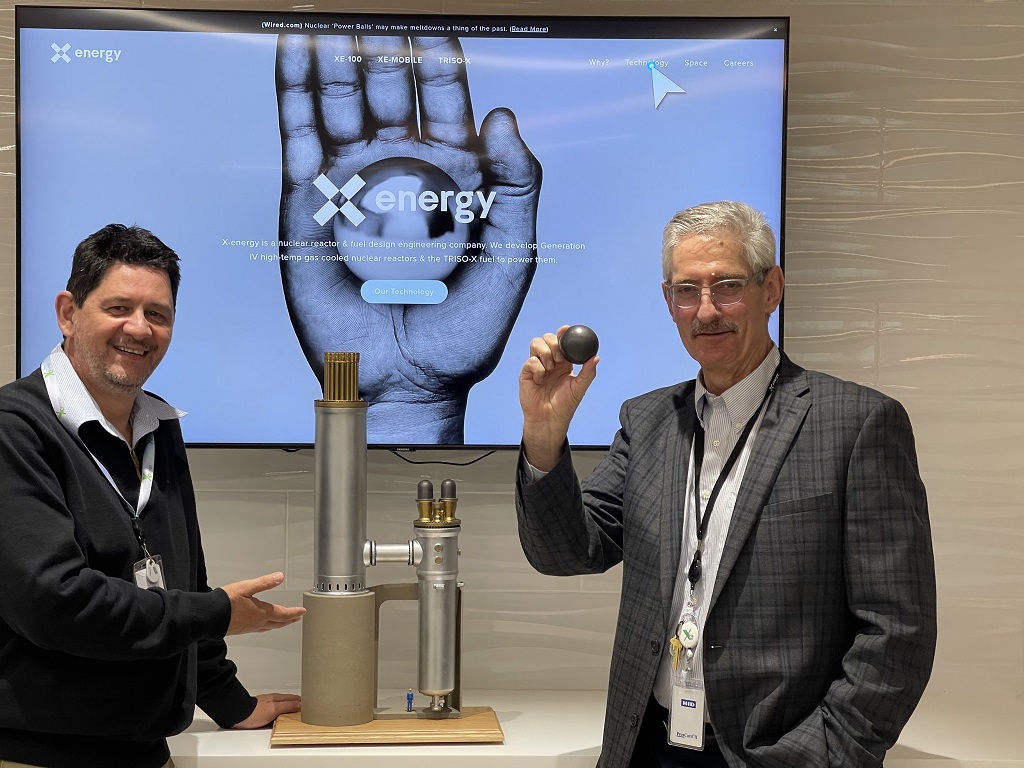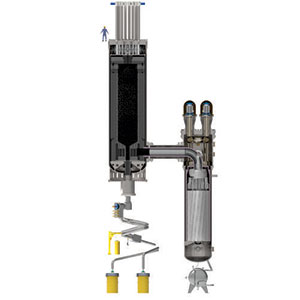By Tom Ferreira
- About a dozen South African nuclear engineers and scientists who were in the first decade of the new millennium involved with South Africa’s abandoned Pebble Bed Modular Reactor (PBMR) project, are now part of a team who is spearheading the development of a similar concept in the United States.
- The South Africans were lured to the US by X-energy, a nuclear reactor and fuel design engineering company based in Maryland. It is not inconceivable that South Africa will be one of X-energy’s international customers when the US concept is commercialised in about seven years’ time.
- A whole host of other former PBMR nuclear scientists and engineers are involved with nuclear projects around the globe. Which raises the question: Why did the Zuma administration pull the plug on the South African PBMR project?
Remember the Pebble Bed nuclear reactor project on which the South African Government pulled the plug just more than a decade ago? A team of South African engineers and scientists who were involved with the project, are now spearheading the development of a similar concept in the United States.
Developed by the Maryland based company X-energy, the US pebble bed reactor could be ready for the market in about seven years’ time. The US$2,5 billion (R35 billion) project will enable X-energy to build the world’s first commercial scale advanced nuclear reactor with Energy Northwest in Washington state.
Quite ironically, it is not inconceivable that South Africa will be one of the company’s first international customers. X-energy are planning to be connected to the grid by 2027, after which the reactor will be commercialised on a large scale.
The local Pebble Bed Modular Reactor (PBMR) project – at its peak the biggest nuclear design project in the world – was abandoned by the Zuma government in 2010 after about R10-billion had been spent on the project over a period of more than ten years. At the time, it was hailed as the concept that could solve the country’s energy shortages. In addition, the plan was to manufacture as many of the components locally as possible, thereby creating thousands of jobs.
The intention was furthermore to sell these reactors to overseas countries such as the USA and the UK. In fact, PBMR (Pty) Ltd at one point had both a US investor (Exelon and later Westinghouse) and a UK investor (British Nuclear Fuels Ltd).
The South African scientists at X-energy were lured to the US some seven years ago, some of them receiving “Einstein visas” (a visa reserved for immigrants with “extraordinary ability”) and green cards in a record time of 14 days. Leading the SA team at X-energy are Dr Eben Mulder, X-energy’s Chief Nuclear Officer, and Dr Martin van Staden, vice-president, Design Engineering. Other South Africans at X-energy are Andries Haasbroek, Lead Systems Engineer; Yvotte Brits, Senior Nuclear System engineer; Theo Odendaal, who is leading the Quality Assurance effort; Dr Herman van Antwerpen, the Analysis lead; Dr Gerrit Botha, Thermodynamic Analyst, Sonat Sen, the Reactor Design lead and Willem Kriel, Design Manager.
In 2015, X-energy won its first Funding Opportunity Announcement (FOA) from the US department of Energy (DOA). “This,” says Dr Mulder, “was more than enough proof that the Americans wanted the South Africans on the team.”
This was followed by one FOA after the other until on 1 March this year, X-energy announced it had signed the Department of Energy’s Advanced Reactor Demonstration Program (ARDP) Cooperative Agreement, officially marking the beginning of the company’s participation in ARDP and partnership with DOE.
The Xe-100 is an 80 MWe (scalable to a 320 MWe four-pack) high temperature gas-cooled reactor. It uses TRi-structural ISOtropic particle fuel (TRISO), manufactured by X-energy. The fuel is similar to the pebble fuel that was under development at the South African Nuclear Energy Corporation (Necsa) at Pelindaba during the first decade of the new millennium.
As was the case with its South African equivalent, the Xe-100 can integrate into large, regional electricity systems as a base and load-following source of carbon-free power. As such, it can optimize grid use of low-emission, intermittent renewables and other clean energy resources.
The reactor is also ideal for project sites and other power applications, including as a source for industrial process heat. As part of the Advanced Reactor Demonstration Program, X-energy and its supply chain partners will deliver a commercial four-unit nuclear power plant of its Xe-100 reactor design and a commercial scale TRISO fuel fabrication facility.
Dr Eben Mulder, who received US citizenship some years ago, says most of the scientists and engineers trained in Nuclear Engineering at the North West University’s Potchefstroom campus and the abandoned PBMR neutronics group, are now working either at X-energy, elsewhere in the US, or in Canada, France, Switzerland, the Netherlands, Belgium, New Zeeland and Australia.
At the Idaho National Laboratory in Idaho Falls in the US, are Dr Gerhard Strydom, now the National Technical Director for the United States Department of Energy’s (DOE) Advanced Reactor Development (ARD) Gas-Cooled Reactors (GCR) campaign, Dr Zain Karriem, Research and Development Staff, and dr. Isabella van Rooyen, the National Technical Director for Advanced Methods for Manufacturing Programs for the Department of Energy-Nuclear Energy Enabling Technologies.
Working for NuScale Power in Corvallis, Oregon, are Dr Van Rooyen’s husband, Philip, a Software Configuration Management Engineer; and Derick Botha, Innovation Manager. Most, if not all, of these engineers and scientists are lost to the country for ever (read more about them and other former PBMR employees working abroad).
Dr Mulder believes pulling the plug on the South African PBMR project was a huge loss for the country. “The project could have put South African in a leading position in terms of nuclear technology and liberated the country from the grip of economic slavery. On the up-side, it afforded the opportunity for this fantastic technology to be fully appreciated, developed and now implemented in the US.”
Dr Mulder points out that the South African PBMR design was technologically very advanced. “In coming to America we decided to put all of that know-how and knowledge under our belts and started off with a market survey to find the sweet spot in the market. That has led to our 4-pack design of 4 Xe-100 reactors each delivering 80 MWe.”
(The Koeberg nuclear power station near Cape Town has two reactors, each with a capacity of 970 MWe. An X-energy 4-pack would therefore have about a third of a Koeberg-type reactor’s capacity.)
“The reactor will be manufactured in-factory to allow for the highest levels of quality assurance. All components will be road transportable. Our reactor pressure vessel diameter is under 4,2 m in diameter and weighs 220 tons. All components can be manufactured locally,” Dr Mulder concludes.
Elsewhere, a group of former PBMR nuclear scientists and engineers employed by USNC are involved with the development of the leading micro Small Modular Reactor (SMR) power plant project, the Micro Modular Reactor, for deployment in Canada. The MMRTM is under development by the Ultra Safe Nuclear Corporation (USNC), a new global technology company with its headquarters in Seattle, Washington.
One of these South Africans is Frederik Reitsma, Director of Analysis at USNC, who is based in Olette, a small village in the Pyrenees mountains in France. Some of the other former PBMR employees on USNC’s payroll are based in South Africa.
According to Reitsma, the MMRTM is an ideal solution for off-the-grid power and heat users such as remote communities or mines where electricity and heat are required for industrial or home use. “The standard plant includes heat storage which makes it easy to integrate with intermittent renewables in a hybrid energy local grid. It is an attractive and affordable option to decarbonise many operations dependent on diesel generators or reliant on intermittent electricity supply, typically for remote communities and mines in many countries, but specifically in Africa, artic and island communities,” he explains.
In the meantime, China is leading the race to bring its High Temperature Reactor to the market. The Chinese HTR-PM is a high-temperature gas-cooled (HTGR) pebble-bed generation IV reactor with a thermal capacity of 250 MW, which is expected to be the first generation IV reactor to enter operation.
Work on the first demonstration HTR-PM power plant, composed of two reactors driving a single steam turbine, began in December 2012 at Shidao Bay Nuclear Power Plant at Weihai in the Shandong province. The pressure vessels of the two reactors were installed in 2016 and the steam generator shell, hot gas duct shell and reactor pressure vessel shell of the first reactor in the HTR-PM demonstration project were successfully paired on 28 April 2020.
Dave Nicholls, chairman of Necsa and the first CEO of PBMR (Pty) Ltd, has an interesting vision of a potential joint venture with China, whereby a reference machine would be built and pebble fuel be manufactured on the Necsa site with the intention to roll out the reactors in South Africa and ultimately the rest of Africa. Watch this space!
Which brings us to the question why the Zuma government pulled the plug on this very promising technology, especially since the then Minister of Public Enterprises, Barbara Hogan, was still upbeat about the project barely a year before she wrote its epitaph. At a conference in July 2009 she said that the “balance of payments has always been the Achilles’ heel in our economy. We need to grow our exports (and) PBMR is ideally suited for that kind of requirement.”
In June 2009, PBMR’s US investor, Westinghouse, reiterated its belief in the PBMR. Said Rita Bowser, the company’s regional vice-president: “We continue to believe in the PBMR. There are good synergies between the U.S. and South Africa to demonstrate the benefits of PBMR.”
Alas, in September 2010 Hogan announced the project’s closure in Parliament providing a list of reasons, including that the PBMR had not been able to secure an anchor customer or another investment partner. She said further investment in the project could well be in excess of an additional R30-billion (an amount which today pales to comparison with the billions that went down the proverbial drain due to state capture and corruption).
Interestingly, she added that, should South Africa embark on a nuclear build programme in the near future, it will not be using Pebble Bed Technology, but “would have to consider options in Generations II and III reactors”. Could president Jacobs Zuma’s plans to strike a nuclear deal with Russia have been the real driving force behind the PBMR’s closure?
| Tom Ferreira, a crisis and project communication specialist based in Cape Town, was communication manager of PBMR (Pty) Ltd from the establishment of the company in 1999 up to its closure in October 2010. |







1 Comment
Thank you for the article. It was great to read how some of the people involved with the PBMR has gone on to make a path on the international scene.
I was involved with PBMR from 2000 to 2010 when it was closed down. I also did a 3 year stint in Spain to continue working in the Nuclear Energy sector, but returned to South Africa in 2014. The comment I would like to make is how a very large portion of the PBMR group of personnel have gone from strength to strength and have made a success of a wide variety of other opportunities, nationally and internationally. PBMR was in the unique position to have under its roof a very strong and successful group of people that have over time demonstrated that they can be and are successful in almost everything they put their minds to. For me this is one of the key oversights or an indication of the shortsightedness employed when the PBMR project was closed down, namely that, the PBMR Employees where “can do” type people and although there was still a tough road ahead in 2010, they would have completed the project successfully, because that is the type of people they are.
Kind regards
Heinrich Engela